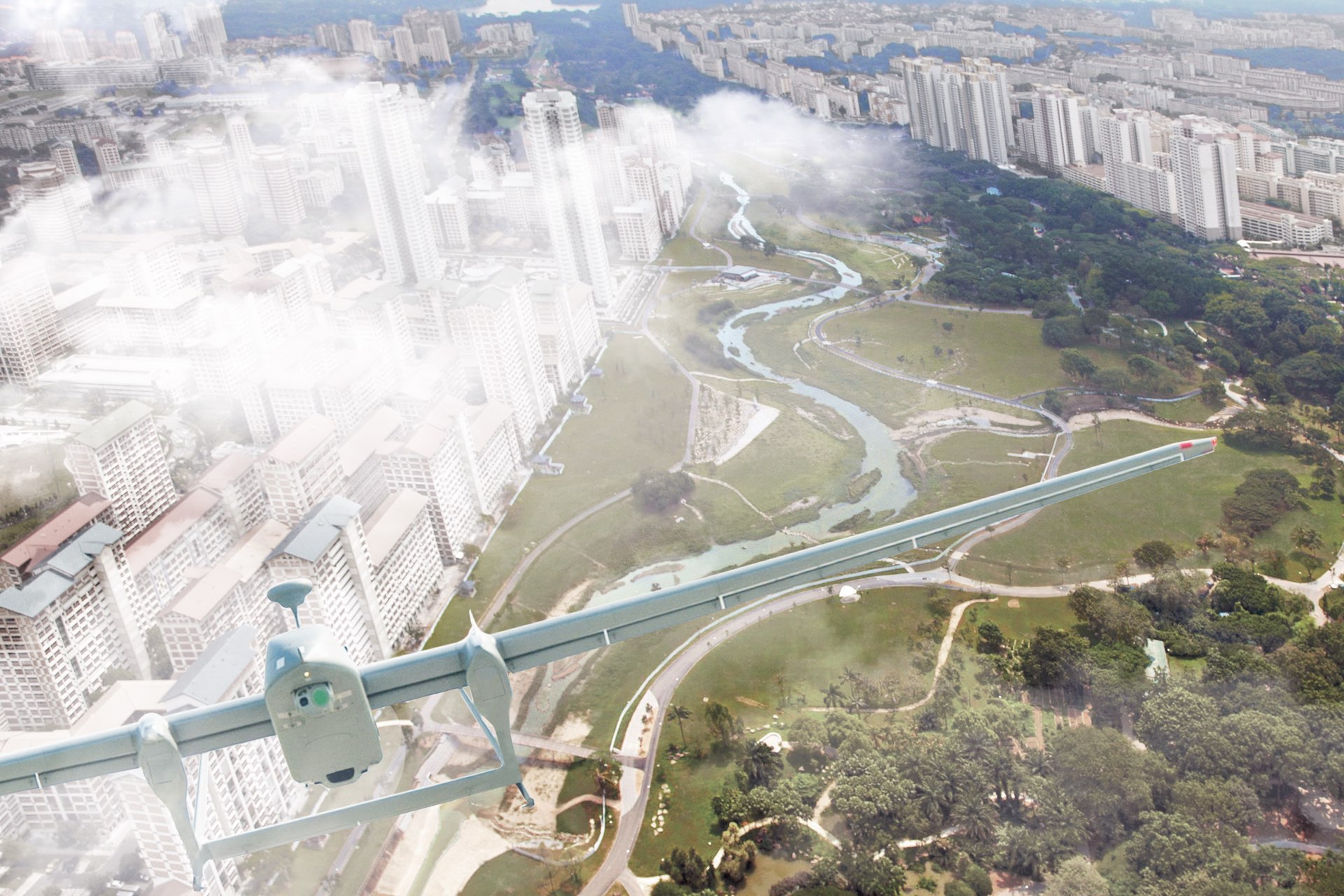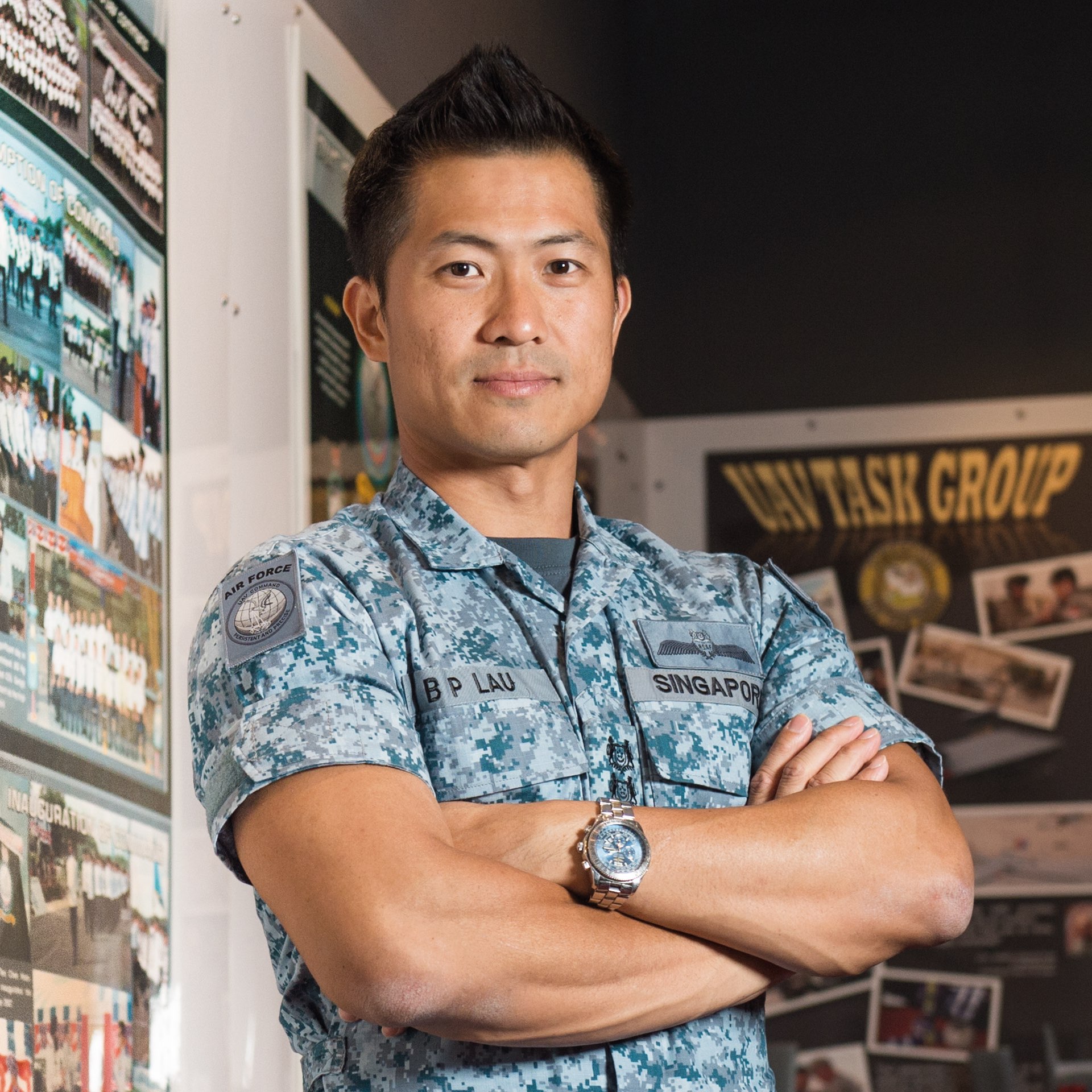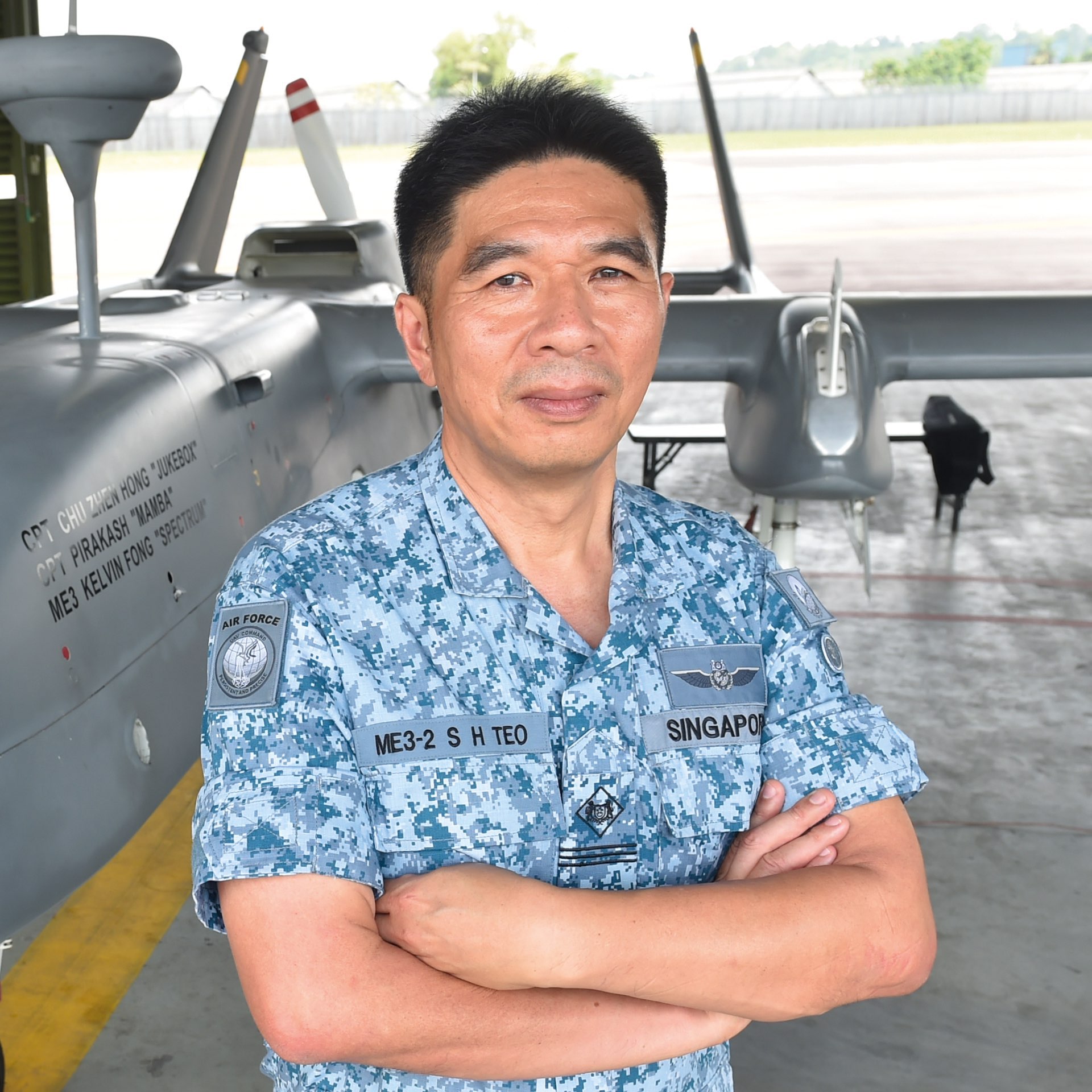WATCHING FROM THE SKIES
The Republic of Singapore Air Force's (RSAF's) Unmanned Aerial Vehicle (UAV) Command marks its 10th anniversary this year. During that time, both its UAVs and people have grown to become crucial enablers in integrated strikes and aerial surveillance.// STORY BENITA TEO
// PHOTOS PIONEER PHOTOGRAPHERS & COURTESY OF 116 SQN
The International Security Assistance Force (ISAF) ground troops in the bomb-blasted province of Oruzgan, Afghanistan, have been watching the deserted building for days. Terrorists have holed up there and are plotting a large-scale attack, one that will devastate villages and leave a trail of civilian and military casualties.
The troops need to move in quickly to take them out, but what kind of defences have the terrorists put up?
Enter the Searcher UAV, operated by the RSAF's UAV Task Group that was deployed in support of the ISAF. It maintains persistent surveillance over the building during the operation, tracking the movement of terrorists and identifying weak spots. It also performs reconnaissance on the building's entry and exit points, as well as aerial surveillance for convoy movements and early warning on potential Improvised Explosive Device (IED) threats.
With these critical pieces of information, the troops are able to storm the building and stop the terrorists before they do more harm.
At the time, it was no small achievement for the RSAF, given that the UAV Command was only formally established three years earlier in 2007.
Flight down memory lane
It's no secret that unmanned platforms are the next frontier in military operations. In the Singapore Armed Forces (SAF), the Navy's Protector Unmanned Surface Vessel can be navigated without a person on board, while soldiers in the 6th Battalion, Singapore Infantry Regiment are experimenting with using unmanned ground and aerial vehicles in their missions.
But did you know it was the RSAF's UAVs that paved the way for the development of these unmanned systems?
"The SAF recognised the potential of UAVs quite early on, as early as 1977, when it acquired the first RPV (Remotely Piloted Vehicle) -- the Mastiff," said Commander UAV Command Colonel (COL) Lau Boon Ping, 37.
"As the SAF evolved, the Air Intelligence, Surveillance and Reconnaissance (AISR) capability provided by UAVs became a key enabler for integrated strikes. It provides the real-time situational awareness necessary to conduct such operations. This, in itself, is a force multiplier that enhances our effectiveness."
The Mastiff and its successor, the Scout RPV, were initially operated by the Army's Field Photo Unit. Later, the RSAF's Tactical Air Support Command (TASC) was set up, and the command of the RPVs was transferred to the Air Force.
Military Expert (ME) 3 Teo Soon Hock explained the rationale behind the move: "The RPVs were air assets, so we were better able to provide the expertise in their operations and ensure the airworthiness of the RPVs."
An Air Force Engineer (AFE) from 811 Squadron (SQN), which provides engineering support for the Heron 1, ME3 Teo has more than 30 years of experience in the RSAF. The 52-year-old was one of the pioneers in TASC who worked on the Scout after the RSAF took over the RPV from the Army in September 1988.
Modern machines
In 1994, the SAF acquired the Searcher UAV, a new unmanned platform that promised significant advantages over the Scout. But learning to operate the more advanced Searcher was a huge challenge.
"The Scout had a very basic system with no GPS (Global Positioning System) and a simple camera. The Searcher was about twice the size, with longer endurance. These were big jumps," former UAV pilot Lieutenant Colonel (LTC) (Ret) Francis Paranjody, 64, recalled.
"It's like you used to drive a Mini, and now you're driving a Mercedes!"
The founding Commanding Officer of 119 SQN, which now operates the Heron 1, added: "There were many gaps in the technology that we had to fix. A two-month overseas training course became five.
"But we persevered. We really pushed the system all the way to its maximum capability and beyond. We started deploying it in 1996 and within two years, we achieved Full Operational Capability."
Today, the UAV Command operates the Hermes 450 (H-450) and Heron 1 UAVs, which joined the flock in 2007 and 2012 respectively. The introduction of the H-450 was also significant as it marked the formal establishment of the UAV Command on 25 May 2007. This was a key milestone in the transformation of the RSAF in the 3rd Generation SAF.
Enhancing integrated strikes
Intelligence and the ability to see earlier and look further are crucial in determining a military's success in battle. The modern UAVs play an important role in providing AISR for the Services in various kinds of missions.
To this end, the UAVs have proven their worth in many exercises, working closely with air and ground forces. During its maiden overseas deployment in 2013, the Heron 1 joined the Light Strike Vehicle Mark (LSV Mk) II and AH-64D Apache Attack Helicopter in Exercise Wallaby, in Australia, where they participated in integrated strike training.
By providing real-time battlefield information on the enemy's location, the Apaches were able to zero in with their aerial rockets and M230 Chain Guns. At the same time, the LSV Mk IIs could move in to take down the targets.
More recently in 2015, the Heron 1 participated in Exercise Forging Sabre, in the United States (US), for the first time. It carried out cooperative lasing together with the F-15SG fighter jets to destroy targets.
In such operations, the Heron 1 fires a laser on the target to mark it. The fighter's bomb, calibrated to follow the laser, then homes in on the target.
Captain (CPT) Hoon Kang Sheng, a Heron 1 pilot from 119 SQN, explained the advantages of lasing: "The UAV can provide a persistent eye on the target. Rather than the pilot trying to estimate and drop the bomb to glide onto the target, lasing is a more accurate option. So our chances of hitting the target are much higher."
ME3 Lim Tong Hung, a Station Lead in 128 SQN, which operates the Heron 1, has noticed a greater demand for the UAV's support in a wide range of missions. The 38-year-old AFE has been working on UAVs since 1999 and is part of the Flight Line Crew who specialise in the maintenance of the Heron 1 and its Ground Control Stations.
"Information is the key to mission success," he said.
"Everyone is asking: 'Can I have video-to-picture (footage) from the UAV before I deploy my troops?"
A change of scenery Overseas exercises are especially valuable to UAV operators because they offer a large airspace to challenge the range and endurance of these machines.
"The overseas training gave me a lot of insight into what the Heron 1 is capable of," said CPT Hoon. Together with the Heron 1, the 28-year-old's first overseas deployment was to Exercise Wallaby in 2013.
"We can search for more targets over a larger area and make use of the bigger airspace. There are also other training units on the ground, like Army and Ground-based Air Defence troops. It makes training more realistic," he added.
Such exercises also provide an invaluable opportunity for Air Imagery Experts (AIRIXs) to hone their analytical skills. Among them is ME1 Wolfgang Pereira, an AIRIX in 116 SQN, which operates the H-450. His role is all about D-C-R -- detect, classify, recognise. And training with other units gives him the chance to put his skills to the test.
"During training, we study terrain and target recognition, where we learn the characteristics of the vehicles, such as its dimensions and what special features it has.
"As we progress, we build on our knowledge so that we can apply it during the missions," he said. The 26-year-old works alongside UAV pilots in the Ground Control Station analysing video footage from the H-450 and detecting, classifying and recognising targets.
The bigger and more varied terrain and tactical formations also allow the AIRIXs to learn more about how and where assets can be deployed.
ME1 Pereira explained: "For instance, when you see a tank, you can expect that it is travelling in a convoy. So you should be able to spot support elements nearby.
"We can then inform the pilots that there could be more vehicles within the radius and advise them to look in those other areas."
COL Lau agreed, highlighting the importance of collaborative overseas exercises for UAV operators: "Overseas, we can train with assets from other countries, like in the recent Exercise Cope Tiger in Thailand.
"The value is in having different targets to detect, classify, recognise and identify. We are able to use these exercises to hone our skills and test our abilities on less common targets." Singapore trains with Thailand and the US in the annual trilateral air exercise.
Strengthening the counter-terrorism front
With the evolution of the security landscape in recent years, the UAV Command has widened its scope of operations from conventional warfighting to counter-terrorism (CT) and urban missions. Today, the UAVs feature regularly in CT exercises with both the SAF and the Home Team, and the Command has been sharpening its capabilities in surveying built-up areas.
"The UAV can provide an overview of a large area, compared to street cameras. So commanders can understand the overall situation and make a better call during operations," CPT Hoon said.
However, locating targets among tall buildings and large crowds poses a challenge to the UAV and its operators, especially when looking down from high up in the air. Pilots therefore have to be attentive to cues that signal suspicious activity.
CPT Hoon explained: "Trying to look for a terrorist within a sea of people from that altitude is not easy because people look like little black dots to us. It's only when there are sudden movements among the crowds that we can detect that there is a potential terrorist."
He added: "We train to maintain as persistent a watch on the target as possible. That's the biggest challenge, because there are many places the targets -- humans and vehicles -- can hide."
ME1 Pereira revealed certain techniques that AIRIXs may use when deciphering a largely homogenous landscape: "Say you're following a white Sedan, and it goes into an area with many other white Sedans. You'll need to pick out (the target car's) unique features. Or we switch the sensors to infrared mode to track its heat signature."
Into the future
As the "grandfather" of unmanned platforms in the SAF, the RSAF's UAVs have amassed a very large and valuable pool of expertise and knowledge. And this information is being put to good use in the SAF, advancing UAV development in the three Services.
"By sharing our experiences with the other Services, we can help jump-start their own (unmanned system) programmes. This comes not just in the form of advice on operations, but safety and doctrine development as well," said COL Lau, who chairs the SAF-wide UAV Development Committee.
"I expect the UAV's role to become more and more prominent in the future," he shared. "Manpower constraints are very real, and unmanned technology such as the UAV helps the SAF do more with fewer people. Technology is always advancing, so the UAVs will become more capable over time."
The UAVs will certainly be helping the SAF look and move ahead of its time.
Into the war zone
The year was 2010. As part of international efforts to assist in the stabilisation and reconstruction of Afghanistan, the Singapore Armed Forces deployed a 52-man Unmanned Aerial Vehicle (UAV) Task Group and the Searcher UAV to the province of Oruzgan.
For three months from August to November, its role was to provide surveillance and reconnaissance support for the International Security Assistance Force. Nations that contributed troops included the United Kingdom, the United States, and NATO member states.
Operating on the edge
Operating in the war zone was a harrowing experience, to say the least.
"Mental tension was definitely high," ME3 Lim recounted.
"We were not attuned to listening out for air raid sirens. In Singapore, we live in a secure zone. But in that environment, you have to be sensitive to unusual sounds while remaining focused on your job."
Noting that he encountered almost 20 rocket attacks throughout his deployment, ME3 Lim described a particular close shave: "A few weeks in, we met with a few rocket attacks. The nearest landed 100 metres from where we were working!
"Luckily our Weapon Locating Radar team was able to provide us with early warning and we sought shelter in time. I will never forget that for the rest of my life."
The crew also learnt to lean on one another for emotional support. ME3 Teo remembered the stream of casualties from the coalition forces being brought into the hospital right next to their hangar.
"It gradually affected the morale of the crew; it affected me as well. The risk factor was really high," he said. "To keep our focus, we would talk and recall our objective, which was to provide support to the coalition forces and enhance their reconnaissance capabilities."
A rare chance
Both ME3 Lim and ME3 Teo agreed that it was the deployment experience of a lifetime. They were also heartened to see the fruits of their labour.
ME3 Lim recalled a particular surveillance mission his Task Force took on, where ground forces were under attack from terrorists. "We were able to provide pictures of where the threats were coming from. Through our videos, reinforcement forces were directed accurately to suppress the enemy. That was when we saw that what we were doing was valuable to the situation."
ME3 Teo was also able to share valuable lessons with his colleagues back home. "It helped to broaden our horizon. It was a rare chance to operate in a larger and more complex military setup. After I came back, I also shared my experience, especially on how we modified the system to overcome the deployment issues we encountered."
Asked if he ever had second thoughts about joining the Task Group, ME3 Teo shook his head firmly. "When I signed on, I was clear about my mission. This is what I do."
Technological edge
With the rapid developments in Unmanned Aerial Vehicle (UAV) technology and systems, how does the Republic of Singapore Air Force (RSAF) remain at the forefront?
They do so through strong support from the defence technology community. The Defence Science and Technology Agency (DSTA), for instance, has been working with the Singapore Armed Forces since the acquisition of the Mastiff in the 1970s. Later, it also helped customise the capabilities of UAVs like the Searcher and Heron 1 to suit the RSAF's needs.
"We worked closely with our RSAF and industry partners to customise and operationalise the different UAV platforms for local operations", said Mr Liu Zhijian, Project Manager (Air Systems), of DSTA's collaboration with the RSAF.
Added the 35-year-old: "We also work with the RSAF to conduct rigorous tests on the UAV systems to ensure that they are robust, reliable and safe for operation."













